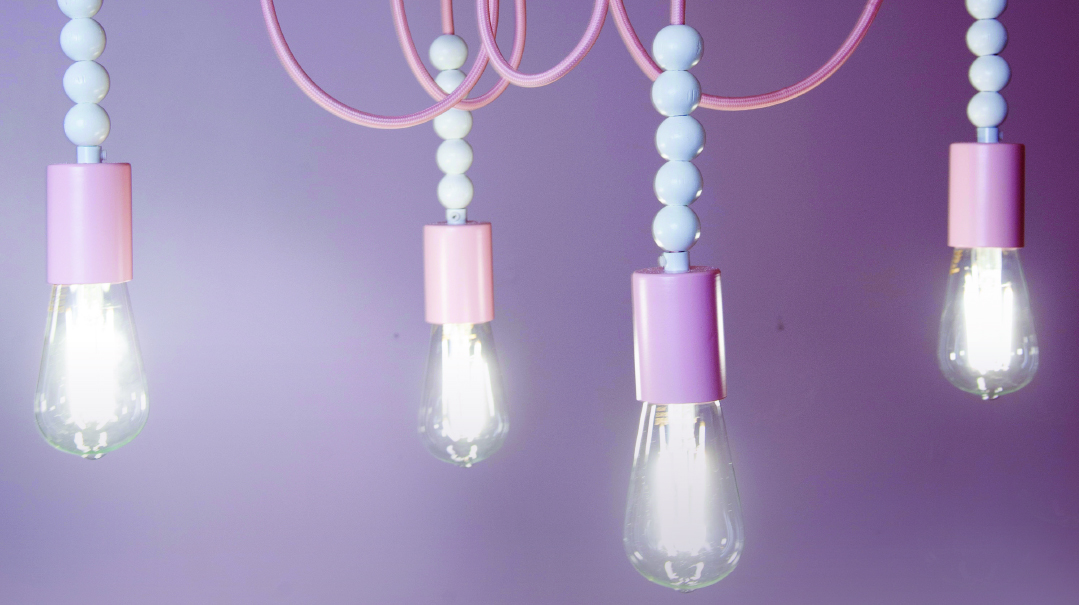Bring Your Creative Visions to Light

If you’re looking to replace your existing fixtures or add new, more contemporary designs to your living space, then read on! The possibilities are endless

Photos: Jeff Zorabedian
How to Wire a Socket
Disclaimer: Electrical material covered is for informational purposes only. Family First takes no responsibility for action taken with this knowledge. We recommend consulting a licensed electrician when undertaking electrical projects.
Supplies:
3 feet of black cloth-covered electric cords (3-wire grounded conductor wires)
black basic strain relief cord grips
decorative gold socket cover
black socket: cap, terminal plate, and shell
pink cord gripper
wire-stripping tool
masking tape
small screw driver (from an eye-glasses kit)
regular size screwdrivers
Warning: The terminal is designed to lock the socket permanently. Don’t assemble the socket with the terminal plate inside before it’s been wired.
Instructions:
Wrap an inch of masking tape 1¼ inches from the tip of the black cloth-covered cord.
Using the pink cord-gripping tool, strip the cloth covering over the midsection of the masking tape to expose the three conductor wires.
Make sure the conductor wires don’t get cut in the process. If they did, snip off the cord just below the cut wires and start again.
Place a strip of masking tape over the tip of the cloth-covered cord, just below the exposed three conductor wires, to ensure the edges of the cloth covering don’t get damaged during the wiring process.
To put on the basic strain relief cord grip, grab the cord grip and untwist the cap. Insert one end of the black cloth-covered cord into the top hole of the cord grip. If it doesn’t slide smoothly and gets stuck, try spinning it instead of sliding it on.
Move the cord grip two to three inches along the cord.
Thread the decorative gold socket cover onto the cord, followed by the cord grip cap.
Next, thread the black socket cap onto the cord. Note: For illustrative purposes, in this picture, the gold socket cover has been removed so that the black socket cap can be clearly seen.
Using the wire stripping tool, strip one end of each of the three conductor wires to expose about 3/16 inch of the stranded copper coils.
Using your fingers, twist each of the strands as tightly as possible.
Flip the black socket cap upside down and locate the grounded terminal screw. Loosen the screw about 1/8 inch. Bend the exposed end of the green grounded wire to a 90-degree angle and wrap the wire around the screw. Then secure the wire into place by tightening the screw.
Locate the positive and negative terminal screws on the terminal plate. The positive terminal is the longer brass part, and the negative terminal is the shorter one.
Flip the terminal plate upside down. Determine which of the two screws is the positive one, and which one is the negative one, by referring to the other side of the terminal plate. Loosen both screws to open up the terminals. Align the terminal plate with the socket cap, so the black wire is aligned with the positive terminal, and the white wire with the negative. Wrap the exposed copper of the black wire around the positive terminal screw, and the exposed white wire around the negative terminal screw.
Push the terminal plate into the black socket cap. It should sit in the ridges inside the cap.
Align the shell with the cap and twist them together until the cap locks into the socket shell. Listen out for a clicking sound to indicate that the cap has securely locked into the shell.
Now that all the wiring of the terminal plate and conductor wires has been completed successfully, it’s time to connect the black cord grip, the gold socket cover, and the black socket.
Twist the black cord grip downward right into the screw hole of the black socket cap until it’s tight. Shake the socket lightly to test for tightness.
Next, connect the cord grip cap with the cord grip. The gold socket cover will be sitting between these two pieces, and when you connect them, it will cover the entire cord grip and black socket. The socket cover might move around slightly; it won’t be a tight fit.
Good luck!
Note: If you’re using your cord to wire several sockets, don’t divide and cut the wire first. Since mistakes can happen, wait to cut the electric cord only once the socket is wired properly. When you’ve successfully wired the second socket, you can cut the electric cord to your desired length and continue on to the third.
Oops! We could not locate your form.







